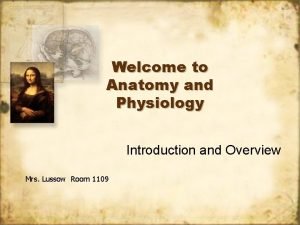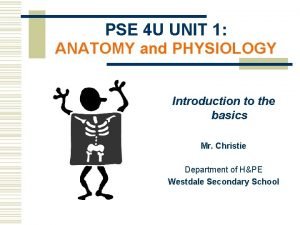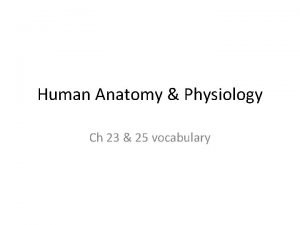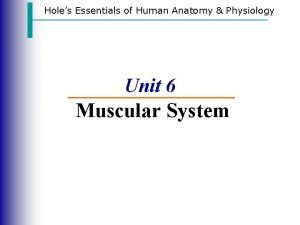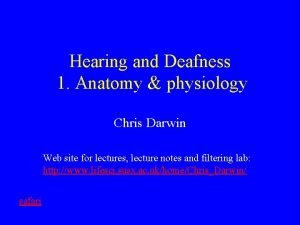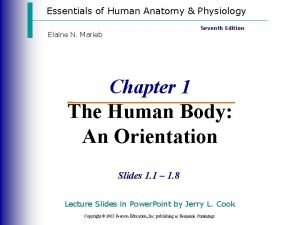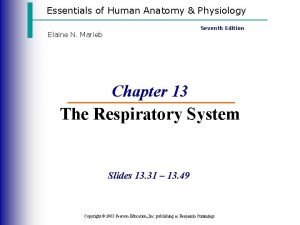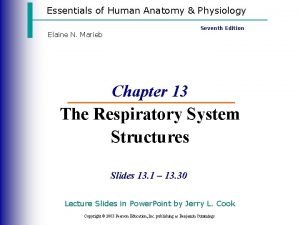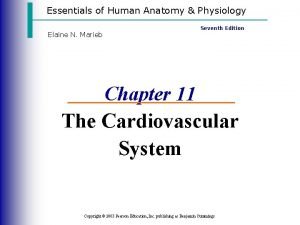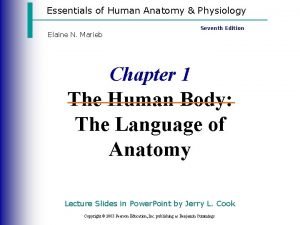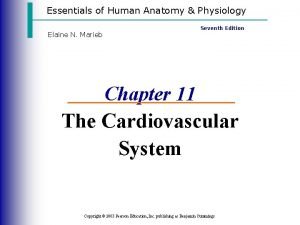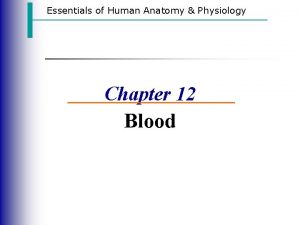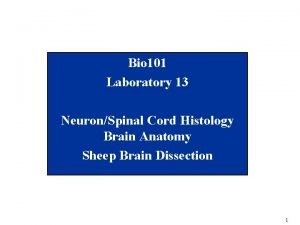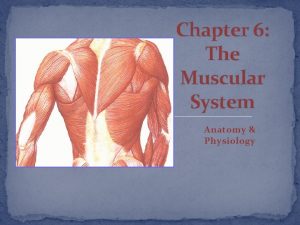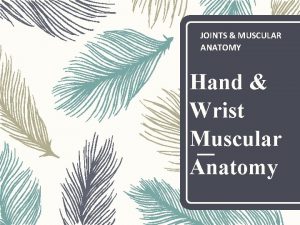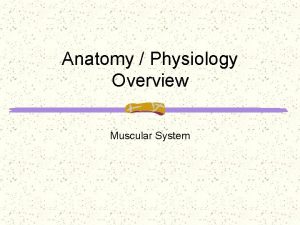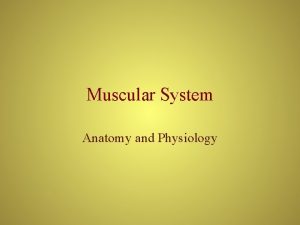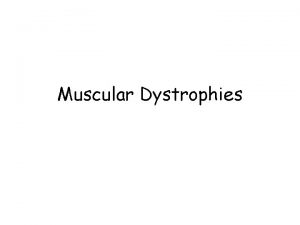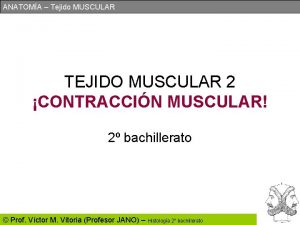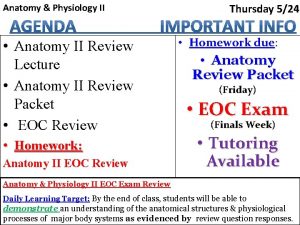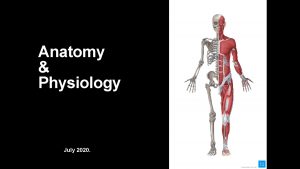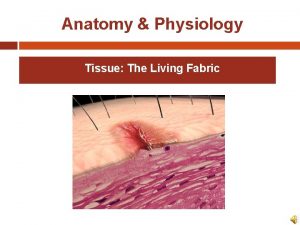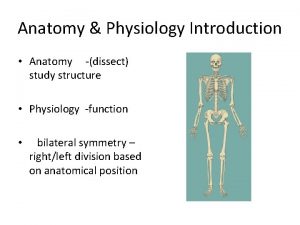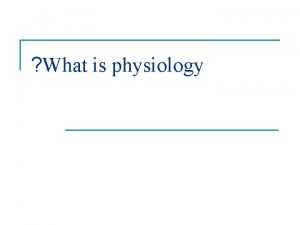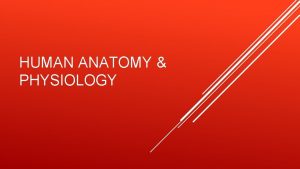Anatomy Physiology Chapter 12 Physiology of the Muscular




































































- Slides: 68

Anatomy & Physiology Chapter 12: Physiology of the Muscular System Mosby items and derived items © 2013, 2010, 2007, 2003 by Mosby, Inc. , an affiliate of Elsevier Inc.

Introduction Muscular system is responsible for moving the framework of the body In addition to movement, muscle tissue performs various other functions Mosby items and derived items © 2013, 2010, 2007, 2003 by Mosby, Inc. , an affiliate of Elsevier Inc. 2

General Functions Movement of the body as a whole or movement of its parts Heat production Posture Mosby items and derived items © 2013, 2010, 2007, 2003 by Mosby, Inc. , an affiliate of Elsevier Inc. 3

Function of Skeletal Muscle Tissue Characteristics of skeletal muscle cells Excitability (irritability)—ability to be stimulated Contractility—ability to contract, or shorten, and produce body movement Extensibility—ability to extend, or stretch, thereby allowing muscles to return to their resting length Mosby items and derived items © 2013, 2010, 2007, 2003 by Mosby, Inc. , an affiliate of Elsevier Inc. 4

Function of Skeletal Muscle Tissue Overview of the muscle cell (Figures 12 -1 and 122) Muscle cells are called fibers because of their threadlike shape Sarcolemma—plasma membrane of muscle fibers Sarcoplasmic reticulum (SR) T tubules—network of tubules and sacs found within muscle fibers Membrane of the SR continually pumps calcium ions from the sarcoplasm and stores the ions within its sacs for later release (Figure 12 -3) Mosby items and derived items © 2013, 2010, 2007, 2003 by Mosby, Inc. , an affiliate of Elsevier Inc. 5

Mosby items and derived items © 2013, 2010, 2007, 2003 by Mosby, Inc. , an affiliate of Elsevier Inc. 6

Mosby items and derived items © 2013, 2010, 2007, 2003 by Mosby, Inc. , an affiliate of Elsevier Inc. 7

Mosby items and derived items © 2013, 2010, 2007, 2003 by Mosby, Inc. , an affiliate of Elsevier Inc. 8

Function of Skeletal Muscle Tissue Overview of the muscle cell (cont) Muscle fibers contain many mitochondria and several nuclei Myofibrils—numerous fine fibers packed close together in sarcoplasm Sarcomere Segment of myofibril between two successive Z disks Each myofibril consists of many sarcomeres Contractile unit of muscle fibers Mosby items and derived items © 2013, 2010, 2007, 2003 by Mosby, Inc. , an affiliate of Elsevier Inc. 9

Function of Skeletal Muscle Tissue Overview of the muscle cell (cont) T tubules Transverse tubules extend across the sarcoplasm at right angles to the long axis of the muscle fiber Formed by inward extensions of the sarcolemma Membrane has ion pumps that continually transport Ca++ ions inward from the sarcoplasm Allow electrical impulses traveling along the sarcolemma to move deeper into the cell Mosby items and derived items © 2013, 2010, 2007, 2003 by Mosby, Inc. , an affiliate of Elsevier Inc. 10

Function of Skeletal Muscle Tissue Overview of the muscle cell (cont) Striated muscle (Figure 12 -4) Dark stripes called A bands; light H band runs across the midsection of each dark A band Light stripes called I bands; dark Z disk extends across the center of each light I band Triad Triplet of tubules; a T tubule sandwiched between two sacs of sarcoplasmic reticulum Allows an electrical impulse traveling along a T tubule to stimulate the membranes of adjacent sacs of the sarcoplasmic reticulum Mosby items and derived items © 2013, 2010, 2007, 2003 by Mosby, Inc. , an affiliate of Elsevier Inc. 11

Mosby items and derived items © 2013, 2010, 2007, 2003 by Mosby, Inc. , an affiliate of Elsevier Inc. 12

Function of Skeletal Muscle Tissue Myofilaments (Figures 12 -5 and 12 -6) Each myofibril contains thousands of thick and thin myofilaments Four different kinds of protein molecules make up myofilaments Myosin Makes up almost all the thick filament Myosin “heads” are chemically attracted to actin molecules Myosin “heads” are known as cross bridges when attached to actin Mosby items and derived items © 2013, 2010, 2007, 2003 by Mosby, Inc. , an affiliate of Elsevier Inc. 13

Mosby items and derived items © 2013, 2010, 2007, 2003 by Mosby, Inc. , an affiliate of Elsevier Inc. 14

Mosby items and derived items © 2013, 2010, 2007, 2003 by Mosby, Inc. , an affiliate of Elsevier Inc. 15

Function of Skeletal Muscle Tissue Four different kinds of protein molecules make up myofilaments (cont) Actin—globular protein that forms two fibrous strands twisted around each other to form the bulk of the thin filament Tropomyosin—protein that blocks the active sites on actin molecules Troponin—protein that holds tropomyosin molecules in place Mosby items and derived items © 2013, 2010, 2007, 2003 by Mosby, Inc. , an affiliate of Elsevier Inc. 16

Function of Skeletal Muscle Tissue Mechanism of contraction Excitation and contraction (Figures 12 -7 through 12 -13; Table 12 -1) A skeletal muscle fiber remains at rest until stimulated by a motor neuron Neuromuscular junction—motor neurons connect to the sarcolemma at the motor endplate (Figure 12 -7) Neuromuscular junction is a synapse where neurotransmitter molecules transmit signals Mosby items and derived items © 2013, 2010, 2007, 2003 by Mosby, Inc. , an affiliate of Elsevier Inc. 17

Mosby items and derived items © 2013, 2010, 2007, 2003 by Mosby, Inc. , an affiliate of Elsevier Inc. 18

Mosby items and derived items © 2013, 2010, 2007, 2003 by Mosby, Inc. , an affiliate of Elsevier Inc. 19

Mosby items and derived items © 2013, 2010, 2007, 2003 by Mosby, Inc. , an affiliate of Elsevier Inc. 20

Mosby items and derived items © 2013, 2010, 2007, 2003 by Mosby, Inc. , an affiliate of Elsevier Inc. 21

Mosby items and derived items © 2013, 2010, 2007, 2003 by Mosby, Inc. , an affiliate of Elsevier Inc. 22

Mosby items and derived items © 2013, 2010, 2007, 2003 by Mosby, Inc. , an affiliate of Elsevier Inc. 23

Mosby items and derived items © 2013, 2010, 2007, 2003 by Mosby, Inc. , an affiliate of Elsevier Inc. 24

Function of Skeletal Muscle Tissue Excitation and contraction (cont) Acetylcholine—the neurotransmitter released into the synaptic cleft that diffuses across the gap, stimulates the receptors, and initiates an impulse in the sarcolemma Nerve impulse travels over the sarcolemma and inward along the T tubules, which triggers the release of calcium ions Calcium binds to troponin, which causes tropomyosin to shift and expose active sites on actin Mosby items and derived items © 2013, 2010, 2007, 2003 by Mosby, Inc. , an affiliate of Elsevier Inc. 25

Function of Skeletal Muscle Tissue Excitation and contraction (cont) Sliding filament model (Figures 12 -12 and 12 -13) When active sites on actin are exposed, myosin heads bind to them Myosin heads bend and pull the thin filaments past them Each head releases, binds to the next active site, and pulls again The entire myofibril shortens Mosby items and derived items © 2013, 2010, 2007, 2003 by Mosby, Inc. , an affiliate of Elsevier Inc. 26

Function of Skeletal Muscle Tissue Mechanism of contraction (cont) Relaxation Immediately after the Ca++ ions are released, the sarcoplasmic reticulum begins actively pumping them back into the sacs (Figure 12 -3) Ca++ ions are removed from the troponin molecules, thereby shutting down the contraction Mosby items and derived items © 2013, 2010, 2007, 2003 by Mosby, Inc. , an affiliate of Elsevier Inc. 27

Function of Skeletal Muscle Tissue Mechanism of contraction (cont) Energy sources for muscle contraction (Figure 1214) Hydrolysis of ATP yields the energy required for muscular contraction ATP binds to the myosin head and then transfers its energy to the myosin head to perform the work of pulling the thin filament during contraction Muscle fibers continually resynthesize ATP from the breakdown of creatine phosphate (CP) Mosby items and derived items © 2013, 2010, 2007, 2003 by Mosby, Inc. , an affiliate of Elsevier Inc. 28

Mosby items and derived items © 2013, 2010, 2007, 2003 by Mosby, Inc. , an affiliate of Elsevier Inc. 29

Function of Skeletal Muscle Tissue Energy sources for muscle contraction (cont) Catabolic pathways Aerobic pathway Occurs when adequate O 2 is available from blood (Figure 12 -15) Slower than anaerobic pathway, thus supplies energy for the long term rather than the short term Mosby items and derived items © 2013, 2010, 2007, 2003 by Mosby, Inc. , an affiliate of Elsevier Inc. 30

Mosby items and derived items © 2013, 2010, 2007, 2003 by Mosby, Inc. , an affiliate of Elsevier Inc. 31

Function of Skeletal Muscle Tissue Energy sources for muscle contraction (cont) Catabolic pathways (cont) Anaerobic pathway (Figure 12 -16) Very rapid, providing energy during first minutes of maximal exercise (Figure 12 -16) May occur when low levels of O 2 are available Results in the formation of lactic acid, which requires oxygen to convert back to glucose, the producing of an “oxygen debt” or excess postexercise oxygen consumption (EPOC) Mosby items and derived items © 2013, 2010, 2007, 2003 by Mosby, Inc. , an affiliate of Elsevier Inc. 32

Mosby items and derived items © 2013, 2010, 2007, 2003 by Mosby, Inc. , an affiliate of Elsevier Inc. 33

Function of Skeletal Muscle Tissue Energy sources for muscle contraction (cont) Skeletal muscle contraction produces waste heat that can be used to help maintain the set point body temperature (Figure 12 -17) Mosby items and derived items © 2013, 2010, 2007, 2003 by Mosby, Inc. , an affiliate of Elsevier Inc. 34

Mosby items and derived items © 2013, 2010, 2007, 2003 by Mosby, Inc. , an affiliate of Elsevier Inc. 35

Function of Skeletal Muscle Organs Muscles are composed of bundles of muscle fibers held together by fibrous connective tissue Motor unit (Figure 12 -18) Motor unit—motor neuron plus the muscle fibers to which it attaches Some motor units consist of only a few muscle fibers, whereas others consist of numerous fibers Generally, the smaller the number of fibers in a motor unit, the more precise are the available movements; the larger the number of fibers in a motor unit, the more powerful the contraction available Mosby items and derived items © 2013, 2010, 2007, 2003 by Mosby, Inc. , an affiliate of Elsevier Inc. 36

Mosby items and derived items © 2013, 2010, 2007, 2003 by Mosby, Inc. , an affiliate of Elsevier Inc. 37

Function of Skeletal Muscle Organs Myography—method of graphing the changing tension of a muscle as it contracts (Figure 12 -19) Twitch contraction (Figure 12 -20) A quick jerk of a muscle that is produced as a result of a single, brief threshold stimulus (generally occurs only in experimental situations) Mosby items and derived items © 2013, 2010, 2007, 2003 by Mosby, Inc. , an affiliate of Elsevier Inc. 38

Mosby items and derived items © 2013, 2010, 2007, 2003 by Mosby, Inc. , an affiliate of Elsevier Inc. 39

Mosby items and derived items © 2013, 2010, 2007, 2003 by Mosby, Inc. , an affiliate of Elsevier Inc. 40

Function of Skeletal Muscle Organs Twitch contraction (cont) The twitch contraction has three phases Latent phase—nerve impulse travels to the sarcoplasmic reticulum to trigger release of Ca++ Contraction phase—Ca++ binds to troponin and sliding of filaments occurs Relaxation phase—sliding of filaments ceases Mosby items and derived items © 2013, 2010, 2007, 2003 by Mosby, Inc. , an affiliate of Elsevier Inc. 41

Function of Skeletal Muscle Organs Treppe—the staircase phenomenon (Figure 12 -21, B) Gradual, steplike increase in the strength of contraction that is seen in a series of twitch contractions that occur 1 second apart Eventually, the muscle responds with less forceful contractions, and the relaxation phase becomes shorter If the relaxation phase disappears completely, a contracture occurs Mosby items and derived items © 2013, 2010, 2007, 2003 by Mosby, Inc. , an affiliate of Elsevier Inc. 42

Mosby items and derived items © 2013, 2010, 2007, 2003 by Mosby, Inc. , an affiliate of Elsevier Inc. 43

Function of Skeletal Muscle Organs Tetanus—smooth, sustained contractions Multiple wave summation—multiple twitch waves are added together to sustain muscle tension for a longer time Incomplete tetanus—very short periods of relaxation occur between peaks of tension (Figure 12 -21, C) Mosby items and derived items © 2013, 2010, 2007, 2003 by Mosby, Inc. , an affiliate of Elsevier Inc. 44

Function of Skeletal Muscle Organs Tetanus—smooth, sustained contractions (cont) Complete tetanus—the stimulation is such that twitch waves fuse into a single, sustained peak (Figure 12 -21, D) The availability of calcium determines whether a muscle will contract; if the calcium is continuously available, then contraction will be sustained (Figure 1222) Mosby items and derived items © 2013, 2010, 2007, 2003 by Mosby, Inc. , an affiliate of Elsevier Inc. 45

Mosby items and derived items © 2013, 2010, 2007, 2003 by Mosby, Inc. , an affiliate of Elsevier Inc. 46

Function of Skeletal Muscle Organs Muscle tone Tonic contraction—continual, partial contraction of a muscle At any one time, a small number of muscle fibers within a muscle contract and produce a tightness or muscle tone Muscles with less tone than normal are flaccid Muscles with more tone than normal are spastic Muscle tone is maintained by negative feedback mechanisms Mosby items and derived items © 2013, 2010, 2007, 2003 by Mosby, Inc. , an affiliate of Elsevier Inc. 47

Graded Strength Principle Graded strength principle—skeletal muscles contract with varying degrees of strength at different times Factors that contribute to the phenomenon of graded strength (Figure 12 -26) Metabolic condition of individual fibers Number of muscle fibers contracting simultaneously; the greater the number of fibers contracting, the stronger the contraction Number of motor units recruited Intensity and frequency of stimulation (Figure 12 -23) Mosby items and derived items © 2013, 2010, 2007, 2003 by Mosby, Inc. , an affiliate of Elsevier Inc. 48

Mosby items and derived items © 2013, 2010, 2007, 2003 by Mosby, Inc. , an affiliate of Elsevier Inc. 49

Mosby items and derived items © 2013, 2010, 2007, 2003 by Mosby, Inc. , an affiliate of Elsevier Inc. 50

Graded Strength Principle Graded strength (cont) Length-tension relationship (Figure 12 -24) Maximal strength that a muscle can develop bears a direct relationship to the initial length of its fibers A shortened muscle’s sarcomeres are compressed; therefore, the muscle cannot develop much tension An overstretched muscle cannot develop much tension because thick myofilaments are too far from the thin myofilaments Strongest maximal contraction is possible only when the skeletal muscle has been stretched to its optimal length Mosby items and derived items © 2013, 2010, 2007, 2003 by Mosby, Inc. , an affiliate of Elsevier Inc. 51

Mosby items and derived items © 2013, 2010, 2007, 2003 by Mosby, Inc. , an affiliate of Elsevier Inc. 52

Graded Strength Principle Graded strength (cont) Stretch reflex (Figure 12 -25) The load imposed on a muscle influences the strength of a skeletal contraction Stretch reflex—the body tries to maintain constancy of muscle length in response to increased load Maintains a relatively constant length as load is increased up to a maximum sustainable level Mosby items and derived items © 2013, 2010, 2007, 2003 by Mosby, Inc. , an affiliate of Elsevier Inc. 53

Mosby items and derived items © 2013, 2010, 2007, 2003 by Mosby, Inc. , an affiliate of Elsevier Inc. 54

Graded Strength Principle Isotonic and isometric contractions (Figure 12 -27) Isotonic contraction Contraction in which the tone or tension within a muscle remains the same as the length of the muscle changes Concentric—muscle shortens as it contracts Eccentric—muscle lengthens while contracting Mosby items and derived items © 2013, 2010, 2007, 2003 by Mosby, Inc. , an affiliate of Elsevier Inc. 55

Mosby items and derived items © 2013, 2010, 2007, 2003 by Mosby, Inc. , an affiliate of Elsevier Inc. 56

Graded Strength Principle Isotonic contraction (cont) Isotonic—literally means “same tension” All of the energy of contraction is used to pull on thin myofilaments and thereby change the length of a fiber’s sarcomeres Mosby items and derived items © 2013, 2010, 2007, 2003 by Mosby, Inc. , an affiliate of Elsevier Inc. 57

Graded Strength Principle Isotonic and isometric contractions (cont) Isometric contraction Contraction in which muscle length remains the same while muscle tension increases Isometric—literally means “same length” Most body movements occur as a result of both types of contractions Mosby items and derived items © 2013, 2010, 2007, 2003 by Mosby, Inc. , an affiliate of Elsevier Inc. 58

Function of Cardiac and Smooth Muscle Tissue (Table 12 -1) Cardiac muscle (Figure 12 -28) Found only in the heart; forms the bulk of the wall of each chamber Also known as striated involuntary muscle Contracts rhythmically and continuously to provide the pumping action needed to maintain constant blood flow Mosby items and derived items © 2013, 2010, 2007, 2003 by Mosby, Inc. , an affiliate of Elsevier Inc. 59

Mosby items and derived items © 2013, 2010, 2007, 2003 by Mosby, Inc. , an affiliate of Elsevier Inc. 60

Function of Cardiac and Smooth Muscle Tissue Cardiac muscle (cont) Cardiac muscle resembles skeletal muscle but has unique features related to its role in continuously pumping blood Each cardiac muscle contains parallel myofibrils (Figure 12 -28) Cardiac muscle fibers form strong, electrically coupled junctions (intercalated disks) with other fibers; individual cells also exhibit branching Syncytium—continuous, electrically coupled mass Mosby items and derived items © 2013, 2010, 2007, 2003 by Mosby, Inc. , an affiliate of Elsevier Inc. 61

Function of Cardiac and Smooth Muscle Tissue Cardiac muscle (cont) Cardiac muscle fibers form a continuous, contractile band around the heart chambers that conducts a single impulse across a virtually continuous sarcolemma T tubules are larger and form diads with a rather sparse sarcoplasmic reticulum Cardiac muscle sustains each impulse longer than in skeletal muscle; therefore, impulses cannot come rapidly enough to produce tetanus (Figure 12 -29) Cardiac muscle does not run low on ATP and does not experience fatigue Cardiac muscle is self-stimulating Mosby items and derived items © 2013, 2010, 2007, 2003 by Mosby, Inc. , an affiliate of Elsevier Inc. 62

Mosby items and derived items © 2013, 2010, 2007, 2003 by Mosby, Inc. , an affiliate of Elsevier Inc. 63

Function of Cardiac and Smooth Muscle Tissue Smooth muscle is composed of small, tapered cells with single nuclei (Figure 12 -30) No T tubules are present, and only a loosely organized sarcoplasmic reticulum is present Ca++ comes from outside the cell and binds to calmodulin instead of troponin to trigger a contraction No striations because thick and thin myofilaments are arranged differently than in skeletal or cardiac muscle fibers; myofilaments are not organized into sarcomeres Mosby items and derived items © 2013, 2010, 2007, 2003 by Mosby, Inc. , an affiliate of Elsevier Inc. 64

Mosby items and derived items © 2013, 2010, 2007, 2003 by Mosby, Inc. , an affiliate of Elsevier Inc. 65

Function of Cardiac and Smooth Muscle Tissue Smooth muscle (cont) Two types of smooth muscle tissue (Figure 12 -31) Single-unit (visceral) smooth muscle Gap junctions join smooth muscle fibers into large, continuous sheets Most common type; forms a muscular layer in the walls of hollow structures such as the digestive, urinary, and reproductive tracts Exhibits autorhythmicity and produces peristalsis Mosby items and derived items © 2013, 2010, 2007, 2003 by Mosby, Inc. , an affiliate of Elsevier Inc. 66

Mosby items and derived items © 2013, 2010, 2007, 2003 by Mosby, Inc. , an affiliate of Elsevier Inc. 67

The Big Picture: Muscle Tissue and The Whole Body Function of all three major types of muscle is integral to function of the entire body All three types of muscle tissue provide the movement necessary for survival Relative constancy of the body’s internal temperature is maintained by “waste” heat generated by muscle tissue Maintains the body in a relatively stable position Mosby items and derived items © 2013, 2010, 2007, 2003 by Mosby, Inc. , an affiliate of Elsevier Inc. 68
 Plyometrics disadvantages
Plyometrics disadvantages The central sulcus divides which two lobes? (figure 14-13)
The central sulcus divides which two lobes? (figure 14-13) Waistline
Waistline Anatomy and physiology chapter 8 special senses
Anatomy and physiology chapter 8 special senses Chapter 13 anatomy and physiology of pregnancy
Chapter 13 anatomy and physiology of pregnancy Chapter 2 basic chemistry anatomy and physiology
Chapter 2 basic chemistry anatomy and physiology Heat and cold
Heat and cold Art labeling activity: figure 14.1 (3 of 3)
Art labeling activity: figure 14.1 (3 of 3) Chapter 10 blood anatomy and physiology
Chapter 10 blood anatomy and physiology Anatomy and physiology chapter 15
Anatomy and physiology chapter 15 Necessary life functions anatomy and physiology
Necessary life functions anatomy and physiology Holes anatomy and physiology chapter 1
Holes anatomy and physiology chapter 1 Gi tract histology
Gi tract histology Medial and lateral
Medial and lateral Chapter 2 human reproductive anatomy and physiology
Chapter 2 human reproductive anatomy and physiology Pectoral girdle acetabulum
Pectoral girdle acetabulum Chapter 6 general anatomy and physiology
Chapter 6 general anatomy and physiology Cranial cephalic
Cranial cephalic Anatomy of upper respiratory tract
Anatomy of upper respiratory tract Tattoo anatomy and physiology
Tattoo anatomy and physiology International anatomy olympiad
International anatomy olympiad Crown plants examples
Crown plants examples Anatomy and physiology bone
Anatomy and physiology bone Peptic ulcer anatomy and physiology
Peptic ulcer anatomy and physiology Cantlie line
Cantlie line Difference between anatomy and physiology
Difference between anatomy and physiology Iliac regions
Iliac regions Anatomy and physiology of blood
Anatomy and physiology of blood 3 layers of muscle
3 layers of muscle Http://anatomy and physiology
Http://anatomy and physiology Appendix anatomy and physiology
Appendix anatomy and physiology Aohs foundations of anatomy and physiology 1
Aohs foundations of anatomy and physiology 1 Aohs foundations of anatomy and physiology 2
Aohs foundations of anatomy and physiology 2 Anatomical planes
Anatomical planes Unit 26 self evaluation answers
Unit 26 self evaluation answers Science olympiad anatomy and physiology 2020 cheat sheet
Science olympiad anatomy and physiology 2020 cheat sheet Gastric emptying ppt
Gastric emptying ppt Anatomy and physiology of diabetes
Anatomy and physiology of diabetes Aohs foundations of anatomy and physiology 1
Aohs foundations of anatomy and physiology 1 Aohs foundations of anatomy and physiology 1
Aohs foundations of anatomy and physiology 1 Anatomy and physiology
Anatomy and physiology Cornell notes for anatomy and physiology
Cornell notes for anatomy and physiology Anatomy and physiology edition 9
Anatomy and physiology edition 9 Holes essential of human anatomy and physiology
Holes essential of human anatomy and physiology Anatomy and physiology unit 7 cardiovascular system
Anatomy and physiology unit 7 cardiovascular system Anatomy and physiology
Anatomy and physiology Aohs foundations of anatomy and physiology 1
Aohs foundations of anatomy and physiology 1 Aohs foundations of anatomy and physiology 1
Aohs foundations of anatomy and physiology 1 Human physiology exam 1
Human physiology exam 1 Welcome to anatomy and physiology
Welcome to anatomy and physiology Physiology of the foot and ankle
Physiology of the foot and ankle Integumentary system psoriasis
Integumentary system psoriasis Physiology vs anatomy
Physiology vs anatomy Pancreas anatomy and physiology
Pancreas anatomy and physiology Anatomy and physiology vocabulary
Anatomy and physiology vocabulary Anatomy and physiology
Anatomy and physiology Muschiul subclavicular
Muschiul subclavicular Anatomy and physiology
Anatomy and physiology Body landmarks diagram
Body landmarks diagram Anatomy and physiology
Anatomy and physiology Anatomy and physiology
Anatomy and physiology Anatomy and physiology
Anatomy and physiology Anatomy and physiology
Anatomy and physiology Figure 11-8 arteries
Figure 11-8 arteries Anatomy and physiology
Anatomy and physiology Anatomy and physiology
Anatomy and physiology Figure 10-1 blood
Figure 10-1 blood Human anatomy and physiology 10th edition
Human anatomy and physiology 10th edition Anatomy and physiology revealed
Anatomy and physiology revealed

















































